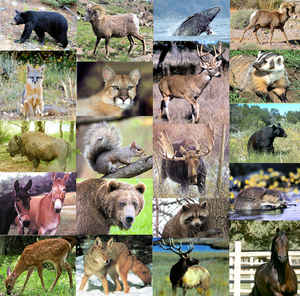Delaware State Wildlife Animal
Grey Fox

(Urocyon cinereoargenteus)
Adopted on June 10, 2010.
The common grey fox became the official state wildlife animal of Delaware when Governor Jack A. Markell signed House Bill No. 354 on June 10, 2010.
With support from fourth grade students at Joseph M. McVey Elementary School, as part of teacher Paul Sedacca's lessons on creative writing, have suggested that the grey fox be designated as Delaware's official state wildlife animal, and have written letters to their legislators supporting this designation, the General Assembly believes it is appropriate to designate the grey fox as Delaware's state wildlife animal in recognition of Delaware's wildlife heritage and commitment to environmental protection and species preservation.
Delaware State Wildlife Animal: Grey Fox

The gray fox (Urocyon cinereoargenteus) is a mammal of the order Carnivora ranging throughout most of the southern half of North America from southern Canada to the northern part of South America (Venezuela and Colombia). This species and the closely related Channel Island fox (Urocyon littoralis) are the only living members of the genus Urocyon, which is considered to be among the most primitive of the living canids. Though it was once the most common fox in the east, and still is found there, human advancement allowed the red fox to become more dominant. The Pacific States still have the gray fox as a dominant. Its specific epithet cinereoargenteus means 'ashen silver'.
Characteristics of the Grey Fox

The gray fox is a peppery gray on top, reddish-brown on its sides, chest and the back of its head. Its legs and feet are also a reddish color. It has a long bushy tail with a black stripe on top. The gray fox has pointed ears, a pointed muzzle and long hooked claws.
Life Cycle
Mating season is between January and April. About 53 days after mating, the female gives birth to one to seven pups. The male helps feed the pups. They are weaned when they are about three months old and are able to hunt on their own when they are four months old. The pups leave their mother in the autumn. The same males and females usually mate together every year.
Behavior
The gray fox can climb and will occasionally forage for food or rest in a tree. It makes its den in rocky crevices, caves, hollow logs and trees. It will sometimes enlarge a woodchuck burrow and use it as a den. Dens are usually used only during the mating season and when raising young.
Range
The gray fox can be found from southern Canada to northern Columbia and Venezuela. It is not found in some mountainous parts of the Northwest United States and in the Great Plains.
Habitat
The gray fox lives in a wide variety of habitats but prefers areas with lots of brush or woods.
Diet
The gray fox is a solitary hunter and eats a wide-variety of foods. A large part of its diet is made up of small mammals like mice, voles and eastern cottontail rabbits. It also eats birds; insects; and plants like corn, apples, nuts, berries and grass. In the summer and autumn, grasshoppers and crickets are an important part of its diet.
Delaware House Bill No. 354
The common grey fox became the official state wildlife animal of Delaware when Governor Jack A. Markell signed House Bill No. 354 on June 10, 2010.
SPONSOR: Rep. Kowalko & Sen. Ennis
Reps. Bennett Brady Mulrooney
Jaques Scott Viola
D.E. Williams
HOUSE OF REPRESENTATIVES
145th GENERAL ASSEMBLY
HOUSE BILL NO. 354
AN ACT TO AMEND TITLE 29 OF THE DELAWARE CODE RELATING TO THE DESIGNATION OF A STATE WILDLIFE ANIMAL.
BE IT ENACTED BY THE GENERAL ASSEMBLY OF THE STATE OF DELAWARE:
WHEREAS, many states have designated a state wildlife animal in symbolic recognition of their state's natural heritage; and
WHEREAS, despite the rich diversity of Delaware's animal species, Delaware is one of only four states which has not designated a state wildlife animal;
and
WHEREAS, fourth grade students at Joseph M. McVey Elementary School, as part of teacher Paul Sedacca's lessons on creative writing, have suggested
that the grey fox be designated as Delaware's official state wildlife animal, and have written letters to their legislators supporting this designation;
and
WHEREAS, the grey fox is a unique and primitive species, believed to be between 7 and 10 million years old, which is indigenous to Delaware; and
WHEREAS, the grey fox is a swift and powerful animal capable of running up to 28 miles per hours and the only member of the canid family which is able
to climb trees; and
WHEREAS, because the grey fox does not hibernate, in the words of the McVey students, it is "always ready like our soldiers at Dover Air Force
Base;" and
WHEREAS, the General Assembly believes it is appropriate to designate the grey fox as Delaware's state wildlife animal in recognition of Delaware's
wildlife heritage and commitment to environmental protection and species preservation.
NOW, THEREFORE:
BE IT ENACTED BY THE GENERAL ASSEMBLY OF THE STATE OF DELAWARE:
Section 1. Amend Chapter 3, Title 29 of the Delaware Code by adding a new "§322" thereto as follows:
"§322. State Wildlife Animal.
The grey fox is the official wildlife animal of the State."
SYNOPSIS
This Act makes the grey fox as Delaware's state wildlife animal.
Delaware Law
The law designating the grey fox as the official Delaware state wildlife animal. is found in the Delaware Code, Title 29, Chapter 3, Section 323.
Title 29 State Government
CHAPTER 3. STATE SEAL, SONG AND SYMBOLS
SECTION 323
§ 323. State wildlife animal.
The grey fox is the official wildlife animal of the State.
77 Del. Laws, c. 286, § 1.;
Taxonomic Hierarchy: Grey Fox
Kingdom: AnimaliaPhylum: Chordata
Class: Mammalia
Order: Carnivora
Family: Canidae
Subfamily: Caninae
Genus: Urocyon
Species: U. cinereoargenteus








